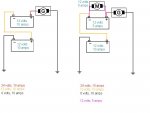When the generator charges, it does not "see" two batteries, it sees only the voltage at the alternator. It's job is to keep that constant.
When two identical batteries recieve an identical draw and and identical charge current, in theory they will remain identically charged.
When you "steal" current from one battery, it recieves less charge.
The alternator does not see "one battery less charged", it sees the sum total of the two to be less, and will increase it's output until the demand is met.
The (crude) diagram shows a two battery charging system, and a two battery charging system with a twelve volts stolen from one battery. This is initial. You can see that the current to the number one battery is cut in half. (That's a pretty dramatic example). With sustained use (time dependant on the amount of current "stolen"), it's reduced charging rate will cause it to become less charged than the other, which will become overcharged.
With the batteries beginning at 12 volts each, as time goes on they will become 11 and 13, 10 and 14, 9 and 15, 8 and 16, and so forth and so on... Always a sum total of 24 volts, but no longer equal. The battery with stolen current is abused by keeping it poorly charged, and the battery without stolen current gets really abused by overcharging it.




